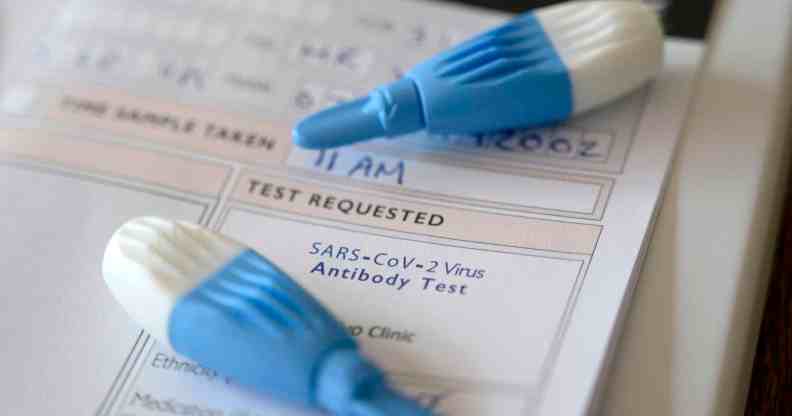New HIV and STI figures spark urgent calls for government action: ‘We need to ramp up testing’

Lancets to prick the tip of the finger are pictured, part of an antibody test kit. (Justin Tallis/Getty)
Lancets to prick the tip of the finger are pictured, part of an antibody test kit. (Justin Tallis/Getty)
New figures shows a drop in new cases of HIV in the UK – but testing rates have not returned to where they were before the COVID-19 pandemic.
Data from the UK Health Security Agency (UKHSA) released on Tuesday (4 October) revealed 2,955 new HIV diagnoses in the UK in 2021 – a 0.2 per cent drop in reported cases from 2020, and a further 33 per cent from 2019.
However, overall HIV testing rates remain an issue after a significant drop in 2020 due to the COVID-19 pandemic, and are “lagging” in all groups apart from gay and bisexual men.
In a separate research document, UKHSA revealed a slight rise of sexually transmitted infections (STIs) in the UK by around 0.5 per cent with 311,604 reported cases, with sexual health screenings increasing by 18.7 per cent.
Syphilis saw the most significant jump in cases – by around 8.4 per cent. Genital herpes cases rose by 5.5 per cent, gonorrhoea cases were up by 1.7 per cent. Chlamydia cases fell by 5 per cent.
The screening numbers are, once again, a promising jump but not enough to return to pre-COVID levels from 2019.
Experts are concerned that increased pressure on sexual healths services as a result of the monkeypox outbreak could impact HIV and STI testing, and have called on the government to act.

Medical syringes and a bottle are seen with a ‘Monkeypox’ sign. (NurPhoto via Getty/ Jakub Porzycki)
“The government needs to act with urgency to properly resource the monkeypox response and mitigate the impact on wider sexual health service to avoid an increase in STIs, unwanted pregnancies and people contracting HIV,” said Terrence Higgins Trust (THT) chief executive Ian Green.
“That includes a clear commitment to prioritising the nation’s sexual health and ramping up HIV testing to achieve the life-changing goal of ending new HIV cases by 2030.”
Green urged people to continue getting tested in order for the UK to hit the government’s target of ending new HIV cases by 2030.
“Today’s data shows that this isn’t happening, with levels lagging behind pre-COVID testing rates in all groups other than gay and bisexual men.
“That needs to be urgently addressed as we won’t end HIV transmissions without achieving it across all populations and right across the country.”
Green also called on the UK government to “set out its vision for sexual and reproductive health in its long-overdue sexual and reproductive health action plan”.
“Currently, we have no national goal around sexually transmitted infections despite rates of STIs being unacceptably high for years.”
Testing rates must be ‘urgently addressed’
While overall 2021 data showed a 15 per cent rise in HIV testing, this is still 20 per cent lower than where things were in 2019.
The rise was predominantly driven by a sharp rise in online testing, which accounted for at least 98 per cent of the increase.
Among gay and bisexual men, test rates have returned to pre-COVID levels.
This is believed to have been influenced by the UK’s current monkeypox response, which has meant significant resources have gone into into testing, as well as COVID recovery.
The highest rates of diagnoses for both HIV and STIs continue to be young gay and bisexual men, as well as Black people.
Testing blood for HIV in emergency departments as routine was praised, with Ian Green of THT saying the strategy was “working”.
“In the first 100 days of this game-changing approach in areas classed as having very high levels of HIV prevalence, there were more than 100 HIV diagnoses made,” he said.
“Pilots show that those diagnosed in A&Es are more likely to be heterosexual, female, and of Black ethnicity than in the sexual health department.
“We need to see opt-out testing rolled out to the 30 areas in the country with high HIV prevalence.”

